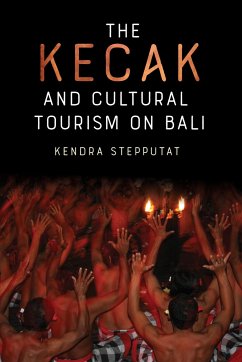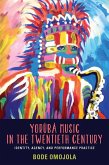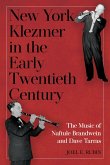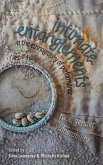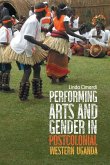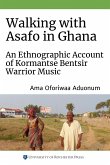Professor Kendra Stepputat
Kecak and Cultural Tourism on Bali
Professor Kendra Stepputat
Kecak and Cultural Tourism on Bali
- Gebundenes Buch
- Merkliste
- Auf die Merkliste
- Bewerten Bewerten
- Teilen
- Produkt teilen
- Produkterinnerung
- Produkterinnerung
Examines the history of one of the best known dramatic dance performance practices on Bali and its connection with cultural tourism.
Andere Kunden interessierten sich auch für
![Yorùbá Music in the Twentieth Century Yorùbá Music in the Twentieth Century]() Bode Omojola (Customer)Yorùbá Music in the Twentieth Century34,99 €
Bode Omojola (Customer)Yorùbá Music in the Twentieth Century34,99 €![New York Klezmer in the Early Twentieth Century New York Klezmer in the Early Twentieth Century]() Professor Joel E. Rubin (Royalty Account)New York Klezmer in the Early Twentieth Century187,99 €
Professor Joel E. Rubin (Royalty Account)New York Klezmer in the Early Twentieth Century187,99 €![Intimate Entanglements in the Ethnography of Performance Intimate Entanglements in the Ethnography of Performance]() Sidra LawrenceIntimate Entanglements in the Ethnography of Performance106,99 €
Sidra LawrenceIntimate Entanglements in the Ethnography of Performance106,99 €![Performing Arts and Gender in Postcolonial Western Uganda Performing Arts and Gender in Postcolonial Western Uganda]() Dr Linda CimardiPerforming Arts and Gender in Postcolonial Western Uganda36,99 €
Dr Linda CimardiPerforming Arts and Gender in Postcolonial Western Uganda36,99 €![Interpreting Court Song in Uganda Interpreting Court Song in Uganda]() Dr Damascus Kafumbe (Series co-editor)Interpreting Court Song in Uganda98,99 €
Dr Damascus Kafumbe (Series co-editor)Interpreting Court Song in Uganda98,99 €![Interpreting Court Song in Uganda Interpreting Court Song in Uganda]() Dr Damascus Kafumbe (Series co-editor)Interpreting Court Song in Uganda35,99 €
Dr Damascus Kafumbe (Series co-editor)Interpreting Court Song in Uganda35,99 €![Walking with Asafo in Ghana Walking with Asafo in Ghana]() Professor Ama Oforiwaa AduonumWalking with Asafo in Ghana40,99 €
Professor Ama Oforiwaa AduonumWalking with Asafo in Ghana40,99 €-
-
-
Examines the history of one of the best known dramatic dance performance practices on Bali and its connection with cultural tourism.
Produktdetails
- Produktdetails
- Eastman/Rochester Studies Ethnomusicology
- Verlag: Boydell & Brewer Ltd
- Seitenzahl: 390
- Erscheinungstermin: 15. November 2021
- Englisch
- Abmessung: 235mm x 157mm x 25mm
- Gewicht: 692g
- ISBN-13: 9781648250316
- ISBN-10: 1648250319
- Artikelnr.: 62026811
- Herstellerkennzeichnung
- Libri GmbH
- Europaallee 1
- 36244 Bad Hersfeld
- gpsr@libri.de
- Eastman/Rochester Studies Ethnomusicology
- Verlag: Boydell & Brewer Ltd
- Seitenzahl: 390
- Erscheinungstermin: 15. November 2021
- Englisch
- Abmessung: 235mm x 157mm x 25mm
- Gewicht: 692g
- ISBN-13: 9781648250316
- ISBN-10: 1648250319
- Artikelnr.: 62026811
- Herstellerkennzeichnung
- Libri GmbH
- Europaallee 1
- 36244 Bad Hersfeld
- gpsr@libri.de
KENDRA STEPPUTAT is Assistant Professor and currently Head of the Institute of Ethnomusicology at the University of Music and Performing Arts (KUG) Graz (Austria).
Introduction Part 1: the Presence Chapter 1. Kecak -- The Music Rhythmic
structures: juru klempung, juru gending (first part), pola cak
Intermission: scales in kecak Melodic elements: juru gending (second part),
juru tembang, and pangalang The lead: juru tarek and dalang Use of stage
space by the jurus and pengecaks Chapter 2. Kecak -- The Dance Movements of
the pengecak group Genre influences on the solo characters' movements
Balinese dance characterization: halus, keras, and kasar The solo
characters' individual dance styles Choreomusical interrelations between
pengecaks and soloists in music and dance Chapter 3. Kecak -- The Drama
Ramayana kakawin Ramayana adaptations in Balinese performing arts The
kecak compromise: stage design, story, entrances The Kecak Ramayana "
Kepandung Sita" kecak performance Chapter 4. The Social Organization of
Kecak Aims and structures of kecak organizations and groups The members of
a kecak group Teaching a kecak group Performance quality and performance
quantity Chapter 5. Kecak -- The Tourist Performance The study of tourism
and culture The development of cultural tourism on Bali Kecak in cultural
tourism Tourists' perspectives The authenticity issue Some concluding
remarks on kecak in tourism Part 2: The History Chapter 6. From Sanghyang
Dedari to Kecak Ritual structures Musical structures Dance structures S
anghyang dedari in the early twenty-first century Performing sanghyang
dedari on film and on stage Sanghyang dedari in performance at the end of
the twentieth century Chapter 7. The First Kecak 1931: Kecak in "Insel der
Dämonen"? 1926 to 1931: Changes in setting, choreography, and music Related
kecak experiments in the 1920s and 1930s: Janger 1935: Kecak documented by
Vicki Baum Villages and organizations: Bedulu and Bona Balinese artists: I
Wayan Limbak and I Nengah Mudarya Expatriates: Walter Spies and Katharane
Mershon Colonial power structures Who created the kecak? Chapter 8. Almost
a Century of Kecak 1930s-1940s: Kecak becomes a tourist attraction
Development in Bona and Bedulu Early tourists' conceptions of the kecak
During and after the Second World War: Kecak deadlocked After the coup
d'état and political persecution: Kecak standardization The early
twenty-first century: The Bali bombings An alternative kecak approach:
Kecak kreasi Some concluding remarks: Does the kecak have a future?
Appendixes 1. Kecak dan Wisata Budaya di Bali (Indonesian Summary) 2. Kecak
Groups of Bali in 2000-2001 (Badung and Gianyar) 3. Facsimile of a letter
from Walter Spies to Leo Spies, 1932 Glossary Bibliography Index
structures: juru klempung, juru gending (first part), pola cak
Intermission: scales in kecak Melodic elements: juru gending (second part),
juru tembang, and pangalang The lead: juru tarek and dalang Use of stage
space by the jurus and pengecaks Chapter 2. Kecak -- The Dance Movements of
the pengecak group Genre influences on the solo characters' movements
Balinese dance characterization: halus, keras, and kasar The solo
characters' individual dance styles Choreomusical interrelations between
pengecaks and soloists in music and dance Chapter 3. Kecak -- The Drama
Ramayana kakawin Ramayana adaptations in Balinese performing arts The
kecak compromise: stage design, story, entrances The Kecak Ramayana "
Kepandung Sita" kecak performance Chapter 4. The Social Organization of
Kecak Aims and structures of kecak organizations and groups The members of
a kecak group Teaching a kecak group Performance quality and performance
quantity Chapter 5. Kecak -- The Tourist Performance The study of tourism
and culture The development of cultural tourism on Bali Kecak in cultural
tourism Tourists' perspectives The authenticity issue Some concluding
remarks on kecak in tourism Part 2: The History Chapter 6. From Sanghyang
Dedari to Kecak Ritual structures Musical structures Dance structures S
anghyang dedari in the early twenty-first century Performing sanghyang
dedari on film and on stage Sanghyang dedari in performance at the end of
the twentieth century Chapter 7. The First Kecak 1931: Kecak in "Insel der
Dämonen"? 1926 to 1931: Changes in setting, choreography, and music Related
kecak experiments in the 1920s and 1930s: Janger 1935: Kecak documented by
Vicki Baum Villages and organizations: Bedulu and Bona Balinese artists: I
Wayan Limbak and I Nengah Mudarya Expatriates: Walter Spies and Katharane
Mershon Colonial power structures Who created the kecak? Chapter 8. Almost
a Century of Kecak 1930s-1940s: Kecak becomes a tourist attraction
Development in Bona and Bedulu Early tourists' conceptions of the kecak
During and after the Second World War: Kecak deadlocked After the coup
d'état and political persecution: Kecak standardization The early
twenty-first century: The Bali bombings An alternative kecak approach:
Kecak kreasi Some concluding remarks: Does the kecak have a future?
Appendixes 1. Kecak dan Wisata Budaya di Bali (Indonesian Summary) 2. Kecak
Groups of Bali in 2000-2001 (Badung and Gianyar) 3. Facsimile of a letter
from Walter Spies to Leo Spies, 1932 Glossary Bibliography Index
Introduction Part 1: the Presence Chapter 1. Kecak -- The Music Rhythmic
structures: juru klempung, juru gending (first part), pola cak
Intermission: scales in kecak Melodic elements: juru gending (second part),
juru tembang, and pangalang The lead: juru tarek and dalang Use of stage
space by the jurus and pengecaks Chapter 2. Kecak -- The Dance Movements of
the pengecak group Genre influences on the solo characters' movements
Balinese dance characterization: halus, keras, and kasar The solo
characters' individual dance styles Choreomusical interrelations between
pengecaks and soloists in music and dance Chapter 3. Kecak -- The Drama
Ramayana kakawin Ramayana adaptations in Balinese performing arts The
kecak compromise: stage design, story, entrances The Kecak Ramayana "
Kepandung Sita" kecak performance Chapter 4. The Social Organization of
Kecak Aims and structures of kecak organizations and groups The members of
a kecak group Teaching a kecak group Performance quality and performance
quantity Chapter 5. Kecak -- The Tourist Performance The study of tourism
and culture The development of cultural tourism on Bali Kecak in cultural
tourism Tourists' perspectives The authenticity issue Some concluding
remarks on kecak in tourism Part 2: The History Chapter 6. From Sanghyang
Dedari to Kecak Ritual structures Musical structures Dance structures S
anghyang dedari in the early twenty-first century Performing sanghyang
dedari on film and on stage Sanghyang dedari in performance at the end of
the twentieth century Chapter 7. The First Kecak 1931: Kecak in "Insel der
Dämonen"? 1926 to 1931: Changes in setting, choreography, and music Related
kecak experiments in the 1920s and 1930s: Janger 1935: Kecak documented by
Vicki Baum Villages and organizations: Bedulu and Bona Balinese artists: I
Wayan Limbak and I Nengah Mudarya Expatriates: Walter Spies and Katharane
Mershon Colonial power structures Who created the kecak? Chapter 8. Almost
a Century of Kecak 1930s-1940s: Kecak becomes a tourist attraction
Development in Bona and Bedulu Early tourists' conceptions of the kecak
During and after the Second World War: Kecak deadlocked After the coup
d'état and political persecution: Kecak standardization The early
twenty-first century: The Bali bombings An alternative kecak approach:
Kecak kreasi Some concluding remarks: Does the kecak have a future?
Appendixes 1. Kecak dan Wisata Budaya di Bali (Indonesian Summary) 2. Kecak
Groups of Bali in 2000-2001 (Badung and Gianyar) 3. Facsimile of a letter
from Walter Spies to Leo Spies, 1932 Glossary Bibliography Index
structures: juru klempung, juru gending (first part), pola cak
Intermission: scales in kecak Melodic elements: juru gending (second part),
juru tembang, and pangalang The lead: juru tarek and dalang Use of stage
space by the jurus and pengecaks Chapter 2. Kecak -- The Dance Movements of
the pengecak group Genre influences on the solo characters' movements
Balinese dance characterization: halus, keras, and kasar The solo
characters' individual dance styles Choreomusical interrelations between
pengecaks and soloists in music and dance Chapter 3. Kecak -- The Drama
Ramayana kakawin Ramayana adaptations in Balinese performing arts The
kecak compromise: stage design, story, entrances The Kecak Ramayana "
Kepandung Sita" kecak performance Chapter 4. The Social Organization of
Kecak Aims and structures of kecak organizations and groups The members of
a kecak group Teaching a kecak group Performance quality and performance
quantity Chapter 5. Kecak -- The Tourist Performance The study of tourism
and culture The development of cultural tourism on Bali Kecak in cultural
tourism Tourists' perspectives The authenticity issue Some concluding
remarks on kecak in tourism Part 2: The History Chapter 6. From Sanghyang
Dedari to Kecak Ritual structures Musical structures Dance structures S
anghyang dedari in the early twenty-first century Performing sanghyang
dedari on film and on stage Sanghyang dedari in performance at the end of
the twentieth century Chapter 7. The First Kecak 1931: Kecak in "Insel der
Dämonen"? 1926 to 1931: Changes in setting, choreography, and music Related
kecak experiments in the 1920s and 1930s: Janger 1935: Kecak documented by
Vicki Baum Villages and organizations: Bedulu and Bona Balinese artists: I
Wayan Limbak and I Nengah Mudarya Expatriates: Walter Spies and Katharane
Mershon Colonial power structures Who created the kecak? Chapter 8. Almost
a Century of Kecak 1930s-1940s: Kecak becomes a tourist attraction
Development in Bona and Bedulu Early tourists' conceptions of the kecak
During and after the Second World War: Kecak deadlocked After the coup
d'état and political persecution: Kecak standardization The early
twenty-first century: The Bali bombings An alternative kecak approach:
Kecak kreasi Some concluding remarks: Does the kecak have a future?
Appendixes 1. Kecak dan Wisata Budaya di Bali (Indonesian Summary) 2. Kecak
Groups of Bali in 2000-2001 (Badung and Gianyar) 3. Facsimile of a letter
from Walter Spies to Leo Spies, 1932 Glossary Bibliography Index

